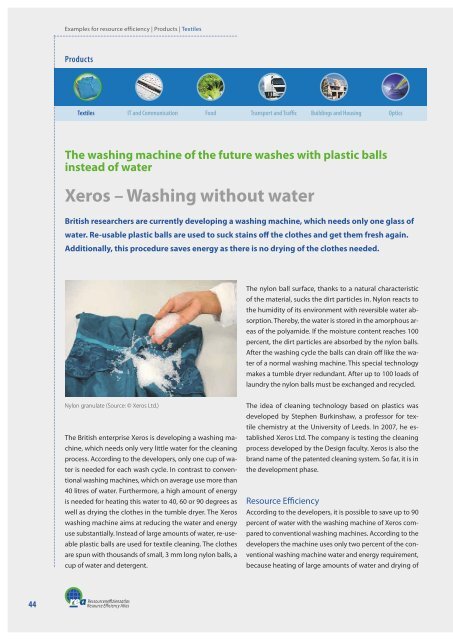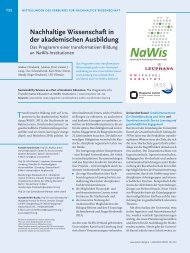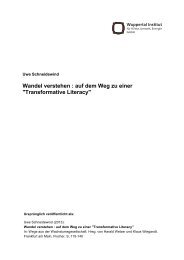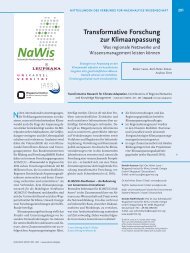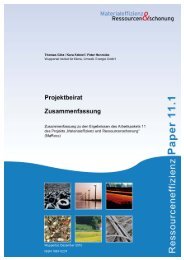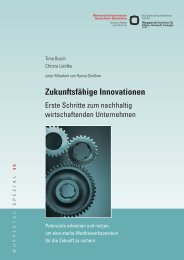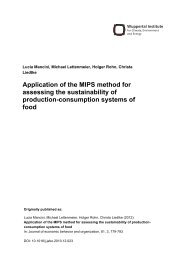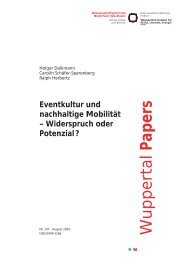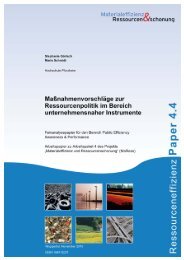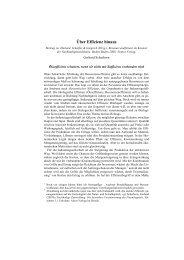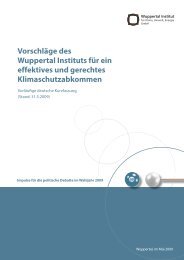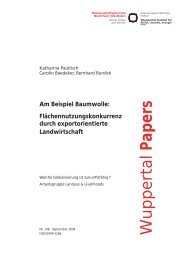Resource Efficiency Atlas - Publication Server of the Wuppertal ...
Resource Efficiency Atlas - Publication Server of the Wuppertal ...
Resource Efficiency Atlas - Publication Server of the Wuppertal ...
You also want an ePaper? Increase the reach of your titles
YUMPU automatically turns print PDFs into web optimized ePapers that Google loves.
44<br />
Examples for resource efficiency | Products | Textiles<br />
Products<br />
Textiles IT and Communication Food Transport and Traffic Buildings and Housing Optics<br />
The washing machine <strong>of</strong> <strong>the</strong> future washes with plastic balls<br />
instead <strong>of</strong> water<br />
Xeros – Washing without water<br />
British researchers are currently developing a washing machine, which needs only one glass <strong>of</strong><br />
water. Re-usable plastic balls are used to suck stains <strong>of</strong>f <strong>the</strong> clo<strong>the</strong>s and get <strong>the</strong>m fresh again.<br />
Additionally, this procedure saves energy as <strong>the</strong>re is no drying <strong>of</strong> <strong>the</strong> clo<strong>the</strong>s needed.<br />
Nylon granulate (Source: © Xeros Ltd.)<br />
The British enterprise Xeros is developing a washing machine,<br />
which needs only very little water for <strong>the</strong> cleaning<br />
process. According to <strong>the</strong> developers, only one cup <strong>of</strong> water<br />
is needed for each wash cycle. In contrast to conventional<br />
washing machines, which on average use more than<br />
40 litres <strong>of</strong> water. Fur<strong>the</strong>rmore, a high amount <strong>of</strong> energy<br />
is needed for heating this water to 40, 60 or 90 degrees as<br />
well as drying <strong>the</strong> clo<strong>the</strong>s in <strong>the</strong> tumble dryer. The Xeros<br />
washing machine aims at reducing <strong>the</strong> water and energy<br />
use substantially. Instead <strong>of</strong> large amounts <strong>of</strong> water, re-useable<br />
plastic balls are used for textile cleaning. The clo<strong>the</strong>s<br />
are spun with thousands <strong>of</strong> small, 3 mm long nylon balls, a<br />
cup <strong>of</strong> water and detergent.<br />
Ressourceneffizienzatlas<br />
<strong>Resource</strong> <strong>Efficiency</strong> <strong>Atlas</strong><br />
The nylon ball surface, thanks to a natural characteristic<br />
<strong>of</strong> <strong>the</strong> material, sucks <strong>the</strong> dirt particles in. Nylon reacts to<br />
<strong>the</strong> humidity <strong>of</strong> its environment with reversible water absorption.<br />
Thereby, <strong>the</strong> water is stored in <strong>the</strong> amorphous areas<br />
<strong>of</strong> <strong>the</strong> polyamide. If <strong>the</strong> moisture content reaches 100<br />
percent, <strong>the</strong> dirt particles are absorbed by <strong>the</strong> nylon balls.<br />
After <strong>the</strong> washing cycle <strong>the</strong> balls can drain <strong>of</strong>f like <strong>the</strong> water<br />
<strong>of</strong> a normal washing machine. This special technology<br />
makes a tumble dryer redundant. After up to 100 loads <strong>of</strong><br />
laundry <strong>the</strong> nylon balls must be exchanged and recycled.<br />
The idea <strong>of</strong> cleaning technology based on plastics was<br />
developed by Stephen Burkinshaw, a pr<strong>of</strong>essor for textile<br />
chemistry at <strong>the</strong> University <strong>of</strong> Leeds. In 2007, he established<br />
Xeros Ltd. The company is testing <strong>the</strong> cleaning<br />
process developed by <strong>the</strong> Design faculty. Xeros is also <strong>the</strong><br />
brand name <strong>of</strong> <strong>the</strong> patented cleaning system. So far, it is in<br />
<strong>the</strong> development phase.<br />
<strong>Resource</strong> <strong>Efficiency</strong><br />
According to <strong>the</strong> developers, it is possible to save up to 90<br />
percent <strong>of</strong> water with <strong>the</strong> washing machine <strong>of</strong> Xeros compared<br />
to conventional washing machines. According to <strong>the</strong><br />
developers <strong>the</strong> machine uses only two percent <strong>of</strong> <strong>the</strong> conventional<br />
washing machine water and energy requirement,<br />
because heating <strong>of</strong> large amounts <strong>of</strong> water and drying <strong>of</strong>


